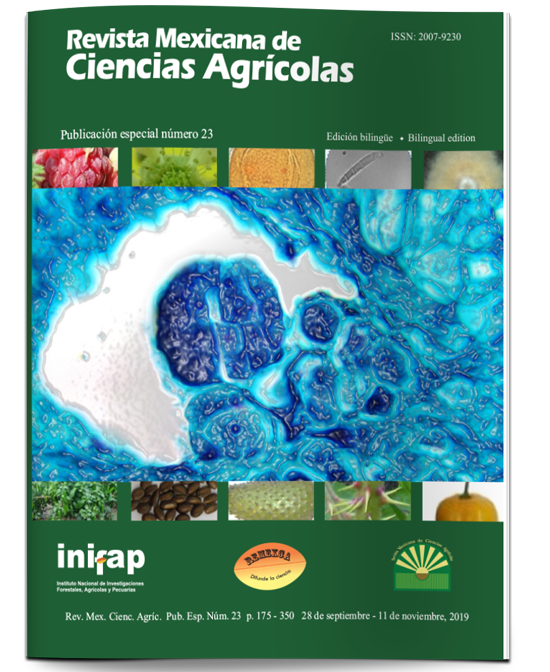Physicochemical characterization of Tinguaraque fruits (Solanum lycopersicum var. Cerasiforme) grown in greenhouse
DOI:
https://doi.org/10.29312/remexca.v0i23.2031Keywords:
plant rescue, protected crop, solanaceae, wild tomatoAbstract
The Tinguaraque (Solanum lycopersicum var. cerasiforme), wild fruit similar to the tomato, grows in oak forests, disturbed areas and cultivated land. Its easy development in different conditions, together with a tart flavor and its small size, make this fruit a more attractive product than the commercial tomato. This work physicochemically characterized fruits of Tinguaraque and compared the response with Cherry tomato, both in greenhouse, as a first step for its improvement and incorporation in the human diet. In August and September of 2017, wild Tinguaraque (JT) plants were collected to obtain seeds, which were germinated together with Cherry tomato seeds (JC) in a greenhouse. Among the parameters evaluated were plant growth pattern, weight and production of mature fruits, for the physicochemical analysis the AOAC methodology was followed registering flavor, energy intake, ethereal extract, crude protein, moisture, dry matter and ash, among others. The information was analyzed through Anova and the differences were obtained by the Tukey test at α= 0.05. The sweetness was observed in the JT cultivar in greenhouse compared to JC (13.4 ±0.5 and 7.6 ±0.8 °Brix respectively) and was slightly higher in pH than in JC (4.3 ±0.1 and 4.1 ±0.1 respectively). Likewise, JT compared to JC recorded similar values in terms of protein (17.5 ±2.2 and 16.6 ±0.6%, respectively) and energy content (5.1 ±0.4 and 4.9B ±0.1 kcal g-1 MS, respectively). These attributes of quality can position the Tinguaraque as a fruit with potential for improvement and immediate commercialization.
Downloads
Downloads
Published
How to Cite
Issue
Section
License
The authors who publish in Revista Mexicana de Ciencias Agrícolas accept the following conditions:
In accordance with copyright laws, Revista Mexicana de Ciencias Agrícolas recognizes and respects the authors’ moral right and ownership of property rights which will be transferred to the journal for dissemination in open access. Invariably, all the authors have to sign a letter of transfer of property rights and of originality of the article to Instituto Nacional de Investigaciones Forestales, Agrícolas y Pecuarias (INIFAP) [National Institute of Forestry, Agricultural and Livestock Research]. The author(s) must pay a fee for the reception of articles before proceeding to editorial review.
All the texts published by Revista Mexicana de Ciencias Agrícolas —with no exception— are distributed under a Creative Commons License Attribution-NonCommercial 4.0 International (CC BY-NC 4.0), which allows third parties to use the publication as long as the work’s authorship and its first publication in this journal are mentioned.
The author(s) can enter into independent and additional contractual agreements for the nonexclusive distribution of the version of the article published in Revista Mexicana de Ciencias Agrícolas (for example include it into an institutional repository or publish it in a book) as long as it is clearly and explicitly indicated that the work was published for the first time in Revista Mexicana de Ciencias Agrícolas.
For all the above, the authors shall send the Letter-transfer of Property Rights for the first publication duly filled in and signed by the author(s). This form must be sent as a PDF file to: revista_atm@yahoo.com.mx; cienciasagricola@inifap.gob.mx; remexca2017@gmail.
This work is licensed under a Creative Commons Attribution-Noncommercial 4.0 International license.



